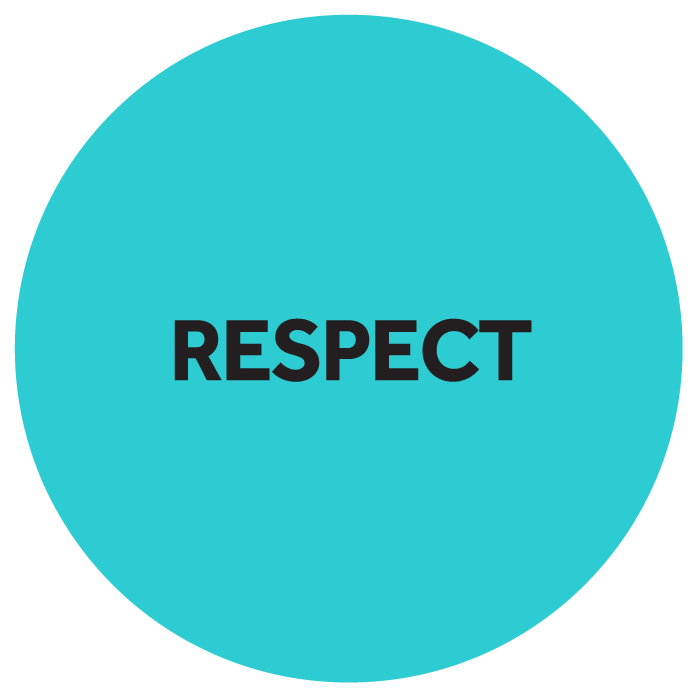
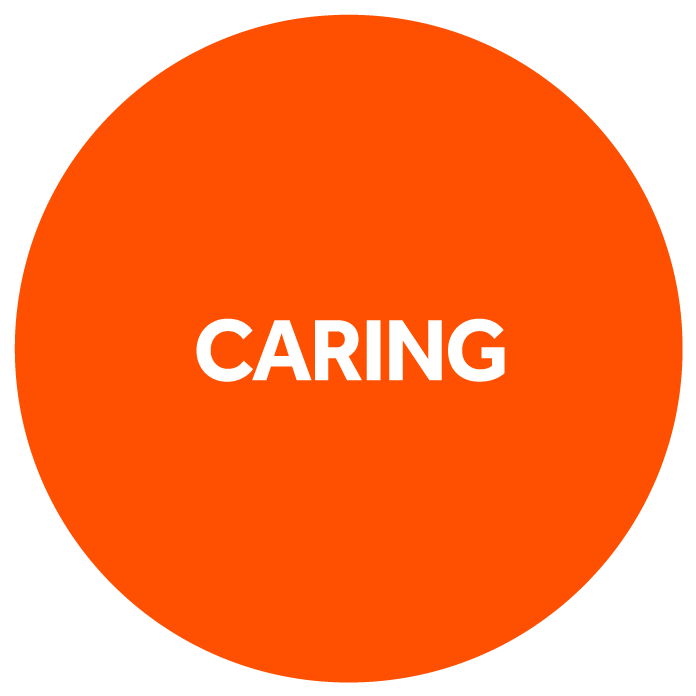




Kindness in the Classroom ®
Our new Kindness in the Classroom® curriculum is a Tier 1 evidenced-based social emotional learning curriculum designed to help schools create a culture of kindness. Each unit teaches six core kindness concepts: Respect, Caring, Inclusiveness, Integrity, Responsibility, and Courage.






Use the links below to find everything you need to effectively teach important kindness skills to your kids. Click here if you are looking for Grades K-5
What makes our lesson plans unique?Note: We use Google Translate to create translated materials, so please be aware that translations may not be 100% accurate.
Make kindness the norm® at your school—here's everything you need to teach important kindness skills to your kids.

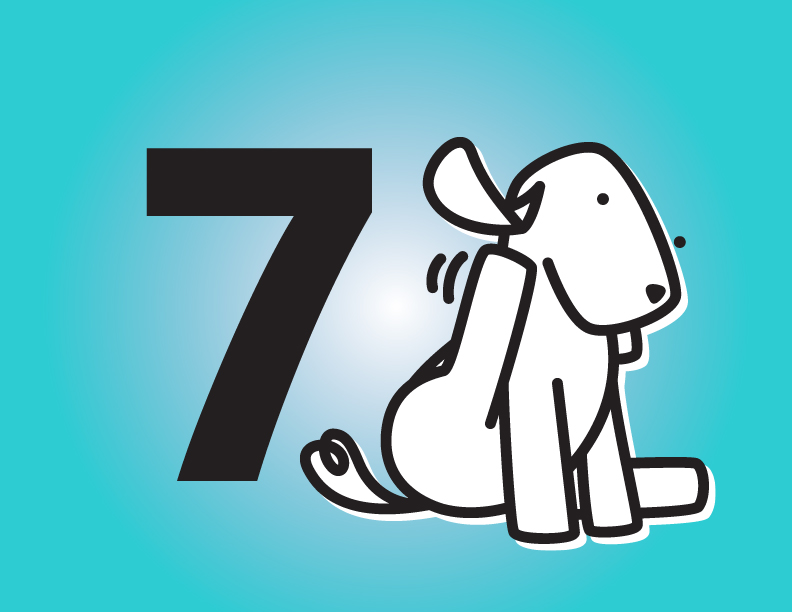

For those of you looking to include social emotional learning into your daily/weekly curriculum, we've added some mini-lessons that can be done at home.
Also check out our distance learning tips for schools and parents and other free school resources below.
In addition to our workplace and general kindness ideas calendar, we created a calendar filled with fun kindness ideas for students and teachers do to while at school!
It’s a perfect addition to any announcement board, classroom or teacher's lounge. You can even use these for for your morning announcements to start off each day with kindness!
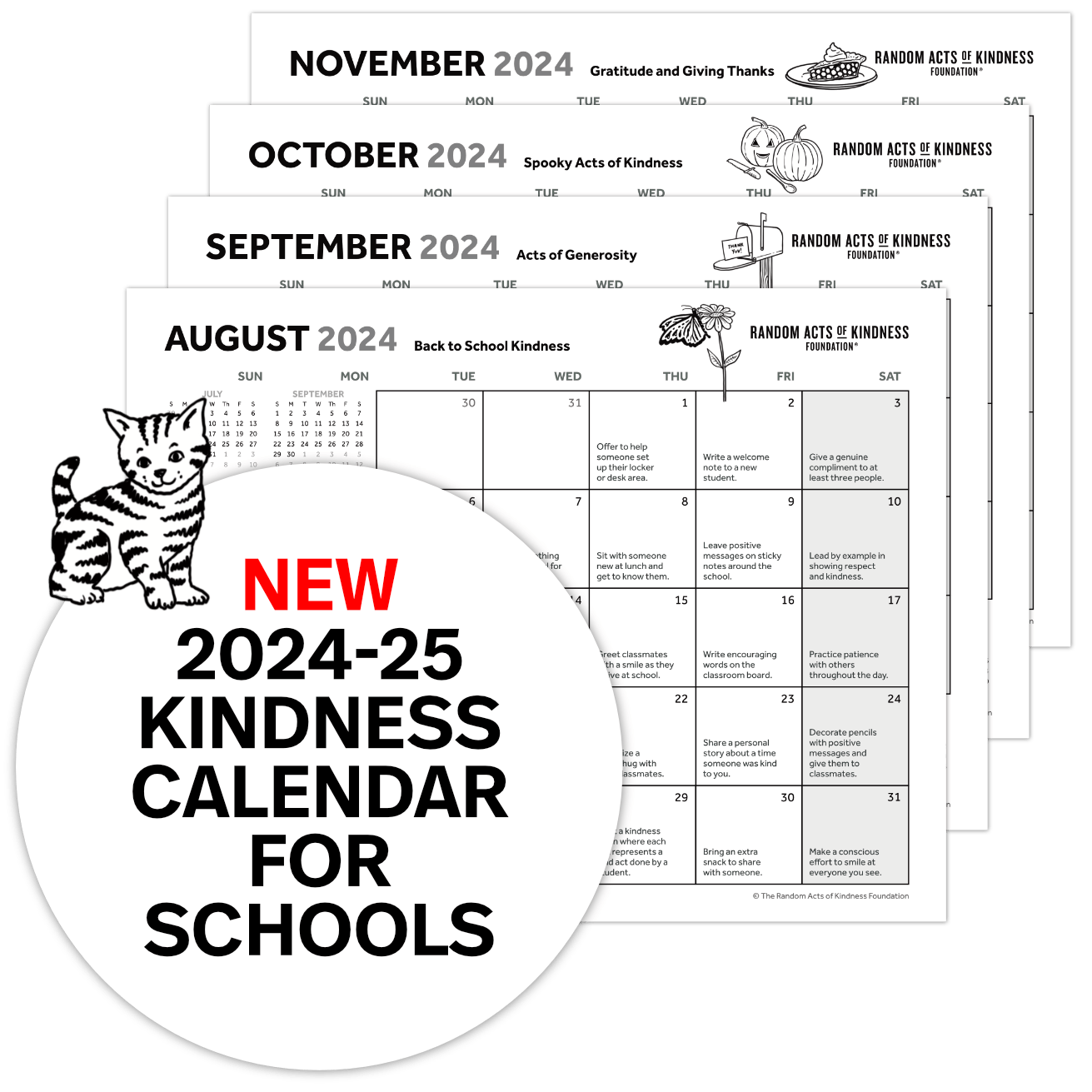

Scroll down to read more about Kindness in the Classroom®
NEW! Teach important kindness skills in an out of school time setting.
Kindness Beyond the Classroom® is a concise yet comprehensive curriculum that you can use to extend kindness beyond the typical school day. There is a mix of whole group and small group lessons that focus on one of our six kindness concepts: Respect, Caring, Inclusiveness, Integrity, Responsibility, and Courage. We also have two “kindness boost” lessons at the end of each unit that you can use when you feel that students need a quick shot of kindness!
Don't expect kindness in schools—teach it! We'll show you how!
We are very proud to announce that all of our training materials are available online so that anyone can use them! Much of the training is focused on self-care for you—the educator. Specifically, building resilience, gratitude, kindness and reconnecting to what you do best—teaching. (That’s why we titled the training “Kindness in the Classroom®: Cultivating Resilience Through Kindness”.)
We hope you take the time to check out the new training! Here is a quick overview video to help you get acquainted. (download video here if you can't access YouTube) If you aren’t an educator, consider using it (with a few tweaks) where you work. The information & activities can be used in any context.
Better yet, share these materials with educators you know! The training (and the curriculum) is fun and will benefit anyone who participates because all the activities and information are based on scientific research. We invite you to share your feedback with us at teacherhelp@randomactsofkindness.org.
Why teaching kindness matters & how we go about it.
The Random Acts of Kindness (RAK) Foundation is a small nonprofit that invests our resources into making kindness the norm. We are rooted in the belief that all people can connect through kindness and that kindness can be taught. We follow a simple framework for everything we do: Inspire, Empower, Act, Reflect and Share. Our evidence-based Kindness in the Classroom® curriculum gives students the social and emotional skills needed to live more successful lives. We create a common language between schools, work and home with all of our resources.
What does social emotional learning (SEL) have to do with kindness?
Reading. Writing. Arithmetic. They’re the keys to the success of our kids, right? But what about the skills that will help when things get tough?
What about the ability to communicate your feelings and needs? To really listen to others? To keep your emotions in check, and understand other points of view that you may not agree with? To empathize with people who are different?
We believe these skills—all linked to kindness—are just as important as academic skills.
Our Kindness in the Classroom ® program was created to integrate intentional kindness skill building with the development of social and emotional competencies. Our lessons include six kindness concepts which, when used consistently, provide students a scaffold to build the necessary skills to move from self-awareness to action.
According to a CASEL (the Collaborative for Academic and Social and Emotional Learning) study, 93% of teachers believe it’s important to teach SEL—and 95% of them believe it can be taught. Their confidence was well founded—because they found that teachers who included SEL programs in their instruction saw an 11-17% increase in the academic scores of their students. Check out our research for more information on the benefits of teaching kindness.

There's a lot to read about kindness here on our website. But one of the most beautiful things about kindness is its ease and simplicity.
That's reflected in our "Kindness Framework", which is what we call the simple, five-step cycle that we follow in each of our lesson plans. Here's how it works:
Kindness in the Classroom lessons teach kindness skills through a step-by step framework of Share, Inspire, Empower, Act, and Reflect. Each lesson starts with the ‘share’ step to reinforce learning from previous lessons. The ‘act’ piece is woven into the lessons but really takes place in the projects.
Each of our lessons starts with a 'share' where the class can share what they've learned and experienced with others since the previous lesson. This reinforces what they've learned and experienced, helps others to experience it and makes it far more likely that they'll express kindness again!
Through various modalities, each kindness lesson is designed to inspire students and allow teachers to feel inspired as well!
Inspiration is good—but transformation begins to happen when students are given the tools that will let them act on that inspiration. The 'empower' step is for teachers to lead the class through discussions designed to empower students to find ways to be kind in their daily lives.
The opportunity to act exists throughout the lessons, but it really comes into play in the projects. Once students have the ideas and the tools, they put it all into action. The unit projects will have students bringing real, tangible kindness into the world.
At the end of each lesson and project, students will have experienced how great it feels to perform acts of kindness. And what does everyone want to do after doing something that feels great (besides ‘do it again')? Talk about it, of course! At the end of each lesson, teachers guide students to reflect on what they've just experienced and learned & identify how doing kindness affects their own lives and the lives of those around them.
Read about other schools & districts who've seen great success using our curriculum.
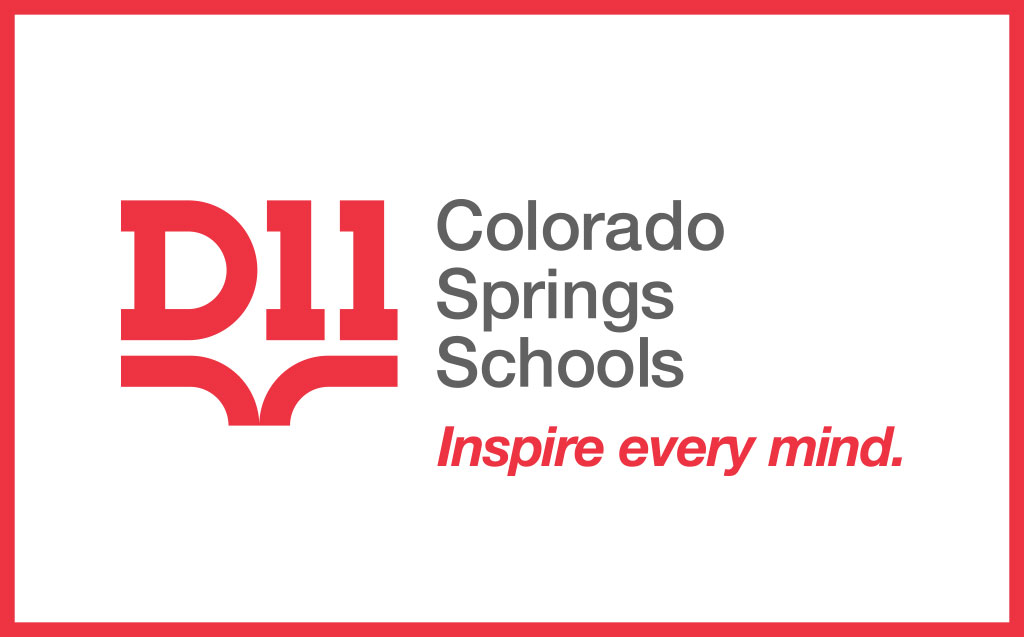
D11 Colorado Springs Schools
Kindness in the Classroom is being implemented in 35 elementary schools (K-5) with a total of over 11,000 students over a five year period between 2017 and 2022. The first year of implementation, five schools taught the Kindness in the Classroom curriculum.
Teaching social emotional competencies, at a universal level, is one of the primary goals within our Comprehensive Student Support Model in Colorado Springs District 11. We were looking for a curriculum that would help increase prosocial behaviors and we have definitely seen the benefit to our community while using Kindness in the Classroom. We chose Kindness in the Classroom for many reasons including the fact that it had strong research behind it showing improved culture and student outcomes.
One of our pain points, as with many schools and districts, is how we’d find the time to implement the program. We ask teachers to spend 30 minutes, once a week, teaching the lessons and they have been able to integrate it very well. Some teachers have gone beyond with projects and ideas outside of the curriculum to embed the concepts into their schools.
Our students come from varying backgrounds and lifestyles, often coming to school lacking the skills needed to effectively and happily socialize, cope with various struggles and still perform academically. Kindness in the Classroom gives students a safe environment to discuss emotions and ethical/moral views with an educated and trusted adult. In one of our schools, we have seen a 38% decrease in discipline referrals after the first year of implementation. Staff, parents and students are really seeing a difference.
One student said, “No one is alone. There are people all around them. People just need to ask to be their friend or play with them.” He explained that he has learned to “never give up, work hard, and help anyone that needs the help.”

Generation Schools Network’s mission is to co-create healthy school ecosystems by partnering with educators, students, families and communities to elevate the education experience.
Along with their school improvement work, GSN has been offering their social/emotional program called “Advocacy” and using the Kindness in the Classroom curriculum in 11 rural schools in Colorado.
At Bayfield Primary School, grade level teams decided to work through the same units at the same time in order to keep a consistent message throughout each grade level. Students created artwork representing their interpretations of the concepts being taught to display throughout the school. The school counselor said, “The most significant outcome is witnessing students being able to advocate for their needs, resolve or avoid conflicts and employ the concepts of social emotional learning.”
Student survey results showed that more than 78% of students agree that they have developed skills that will help them succeed in school, work and life and 93% of teachers reported that they have developed meaningful relationships with their students through GSN’s Advocacy Program and use of the Kindness in the Classroom curriculum.

Rocky Top Middle School
One of the priorities at Rocky Top Middle School has always been to intentionally address the social emotional needs of staff and students in order to increase academic achievement and maintain a positive climate and culture throughout the building. However, last year was the first time we changed the structure of the master schedule to ensure delivery of direct instruction in the area of social emotional learning.
Using Kindness in the Classroom as the foundation for that class, our staff was empowered to facilitate learning in a creative way that allowed them to truly connect with their students. Families reported that their children felt safe and welcome in the school environment and that the direct instruction of the KiC curriculum gave them a strong foundation for conversations at home.
“Our students are really excited to focus on kindness. In fact, the Yearbook Club declared kindness as the theme of the entire yearbook. The cover boasts the quote, 'Kindness is the opportunity that we all have everyday to change the world.' The first photos in the yearbook show students displaying signs advertising 'We choose kindness here!' Throughout the yearbook there were even quotes and poems from students about kindness received and given.
Since including Kindness in the Classroom as our social emotional learning curriculum there has been a significant increase in academic achievement and the positive climate and culture throughout the building.
Teaching kindness really does make a difference!
The Random Acts of Kindness Foundation has taken our highly effective, evidence-based Kindness in the Classroom social emotional learning curriculum and only made it better. By including a focus on equity, teacher self-care, and digital citizenship, we are excited to share a more engaging, relatable, and inclusive curriculum.
According to their findings, teachers using our curriculum report feeling more connected to their students, seeing more kindness in their classrooms, halls and on the playgrounds, and noticing their students demonstrating more empathic, caring traits.
That’s great news, but it doesn’t stop there. The teachers also noted improved trust, fewer referrals to the office, more respect between students, and a generally more positive school and classroom culture!
To understand why social-emotional learning is so important, read this Teaching the Whole Child brief created by the Center on Great Teachers & Leaders at American Institutes for Research. It also includes good information on practical ways schools & districts can incorporate social-emotional learning programs into their schools.
For those of you looking to include social emotional learning into your daily/weekly curriculum, we've added some mini-lessons that can be done at home.
Also check out our distance learning tips for schools and parents and other free school resources below.
Even more resources to help you teach kindness to your kids.

Our handy guide with tips on how to start a kindness club at your school.
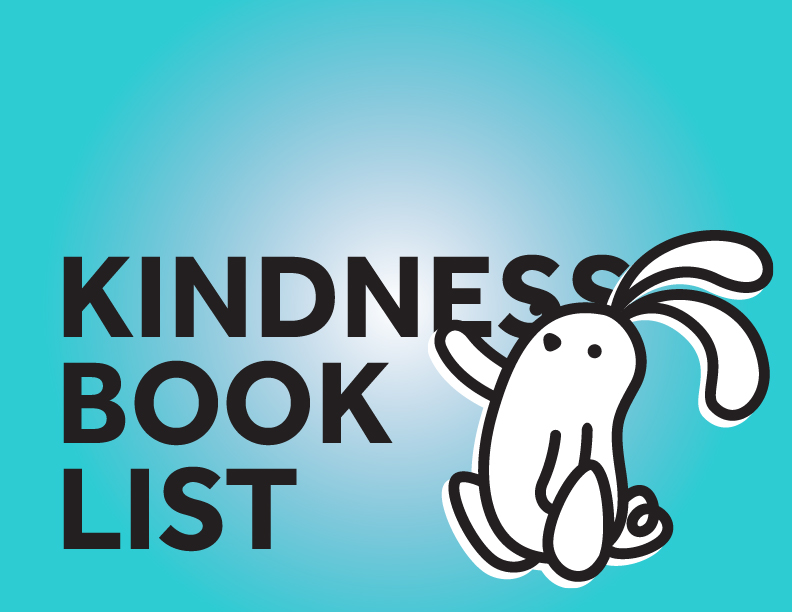
Our hand-picked collection of kindness-themed books used in our lessons. Listed by grade.

Need a few fun game ideas to play with kids? Grab our list of games and go!

Introduce the Kindness in the Classroom® curriculum to parents & caregivers at home.
Let us know if you have questions that aren't covered below.
What is Kindness in the Classroom ® ?
Kindness in the Classroom ® is a free Tier 1 evidenced-based social emotional learning curriculum designed to helps schools create a culture of kindness. By including a focus on equity, teacher self-care, and digital citizenship, The Random Acts of Kindness Foundation is excited to share an engaging, relatable, and inclusive curriculum.
How much does Kindness in the Classroom ® cost?
THE CURRICULUM IS COMPLETELY FREE OF CHARGE. Many of the materials required for lessons are items that teachers and schools already have on hand. There are some books that are required for a few of the lessons which might need to be purchased, though most lessons link to a video of someone reading the book if funds are not available to purchase the required books.
How long are the lessons and how much preparation is needed?
Teachers’ time is precious. With that in mind, the lessons and projects can be taught for 30-45 minutes once a week. Each lesson gives a time estimate to aid teachers in adapting the lesson into shorter class periods. Most teachers report needing no more than 15 minutes to prepare for the lessons.
What is the Kindness Framework?
Do I need to teach all the lessons? Do they need to be taught in order?
Lessons are sequential within each unit. The units are designed to help students develop their social emotional skills through a process of being inspired, feeling empowered to be kind, acting on that feeling, reflecting on what they have learned, and sharing their experiences. However, you may implement selected lessons based on your students needs.
How does the curriculum fit with district, state and national standards?
All Kindness in the Classroom ® lesson plans have been mapped to the five CASEL Core Social Emotional Learning (SEL) Competencies, the Centers for Disease Control and Prevention’s National Health Education Standards (NHES), the International Society for Technology in Education (ISTE) Standards, when applicable, and the national Common Core State Standards for English Language Arts & Literacy, Mathematics, History/Social Studies, and Science & Technical Subjects. Utilization and adoption of these national standards and competencies vary by state, however, teachers can align their own state standards with each lesson as well. For each unit, a Standards Map was created to summarize each of the standards met by all lessons within that unit.
Why is it important to teach social and emotional learning (SEL)?
There are so many reasons! Aside from increased academic performance, SEL programs like Kindness in the Classroom ® improve attitudes and behaviors and reduce emotional distress. Research shows that students receiving the curriculum had greater empathy and sympathy for fellow students and teachers, were intrinsically motivated to be kinder and caring and showed decreased aggressive and antisocial behaviors. Interestingly, teachers reported they had significantly fewer conflicts with their students after teaching the curriculum and said they had more time for teaching. all resulting in students having more time for learning.
How can I successfully implement Kindness in the Classroom ® ?
The fact that you’re even considering implementing SEL in your classroom means you’re already on the road to success. To get started, you can complete an initial Implementation Assessment to help plan a roadmap to successfully bring Kindness in the Classroom to your school—with full support of staff, administration and parent / guardians. After that, you can check our Grades K-5 and Grades 6-8 how to get started documents and then review the teacher training materials.
Do I need training in order to implement Kindness in the Classroom ® ?
Training is not required to use the curriculum, but it is encouraged. The lessons are designed for ease of use and minimal preparation. If your school is planning to use the curriculum within a grade level or throughout the school, it is beneficial to use our free training called Cultivating Resilience Through Kindness to get acquainted with our materials.
Does the entire school need to implement Kindness in the Classroom ® ?
While it is advantageous to use Kindness in the Classroom ® school-wide, you may also wish to implement by grade levels first, and then roll out the program to other grades later.
Is Kindness in the Classroom ® an anti-bullying program?
Kindness in the Classroom ® is designed to pro-actively build healthy relationships among students and a culture of kindness within your school. With this effective curriculum, bullying can oftentimes be prevented.
Does Kindness in the Classroom ® align with CASEL?
Yes, the Collaborative for Academic, Social, and Emotional Learning (CASEL)—the world’s leading organization for advancing social emotional learning—has recognized Kindness in the Classroom ® as a CASEL SELect program for excellence in supporting SEL in schools and districts nationwide.
Is Kindness in the Classroom ® culturally responsive? (Equity)
The curriculum has been rated “excellent” by the Equity Project based on this report.
Is there a difference between the K-5 and 6-8 curriculum?
Yes! The elementary and middle school programs were designed differently with the needs of those children and schools in mind. Please see our implementation guide for K-5 here and the guide for grades 6-8 here.
What does the research say about the effectiveness of Kindness in the Classroom ® ?
Please refer to our Research & Reports section to review several reports we commissioned on the effectiveness of Kindness in the Classroom®. Spoiler alert: it works!